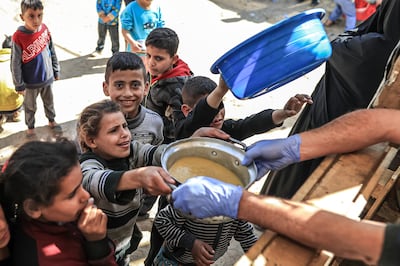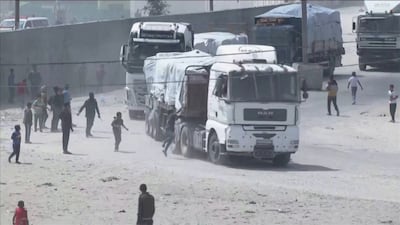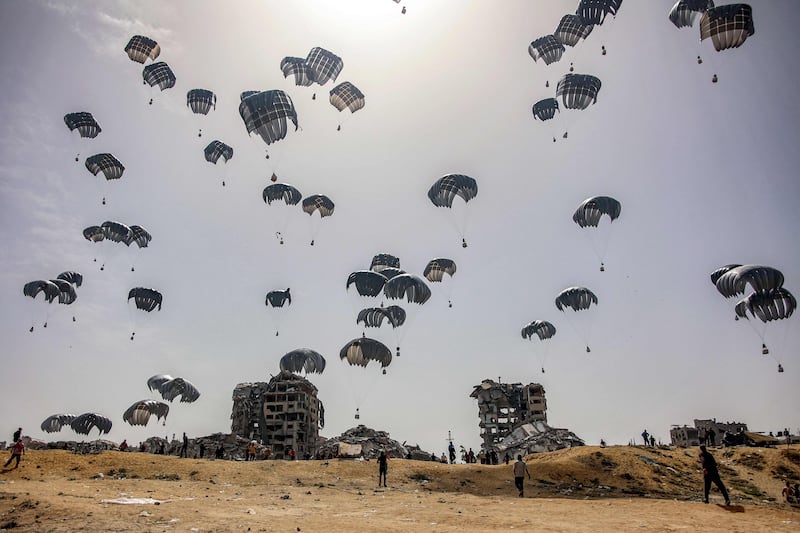Live updates: Follow the latest on Israel-Gaza
British officials said supply ship Cardigan Bay would provide the US military offshore accommodation for its Gaza operations to ensure its "no boots on the ground pledge" would be kept, as aid agencies examine their use of military-trained support for teams working in the strip.
Deliveries are expected to begin in early May with the equivalent of around 90 lorries per day of aid, which will “quickly scale up” to the full operational capacity of 150 lorries daily.
The operation is expected to last several months, with US soldiers based on the British naval logistical support ship.
With the US pledging troops will not enter Gaza, experts have been weighing up just how much military-trained support humanitarian teams will need to roll out the desperately needed aid in Gaza, where around a third of children under the age of two are acutely malnourished.
It comes amid warnings of a risk of the potential of “militarising humanitarian aid”, with charities potentially hiring combat veterans to bring in relief, a former UN chief told The National.
Amid chaos from the Israeli invasion, there is a suggestion that aid agencies are looking to use staff with military backgrounds to be able to deal with wartime situations.
British and US aid agencies have also told The National that it was becoming “extremely difficult and dangerous” to get aid into the territory, with children now experiencing famine.
Before the latest war, around 500 lorries carrying food, fuel and other supplies entered Gaza daily, supplemented by fish and produce farmed within the territory.
Deliveries of aid plummeted following the invasion and have since increased slightly to an average of 195 lorries each day in the two weeks running up to Monday, according to UN figures. The US jetty would lift this figure and improve supplies to the most isolated parts of Gaza.
But that is still far short of the 300 lorries of food the World Food Programme said is required each day to meet people's basic needs.

Surviving in conflict
In the Israeli missile attack that killed seven World Central Kitchen workers in Gaza on April 1, three were ex-British military, some with special forces backgrounds, working as private security contractors.
They are among more than 200 humanitarian workers killed in Gaza, a toll the UN says is three times higher than any previous number for aid workers in a single year of any war.
Mark Bowden, the former UN deputy special representative in Afghanistan, said the nature of war had changed dramatically over the past two decades “with far more fragmented conflict and far more atomised conflict”.
He was asked by The National if the exceptional violence in Gaza meant that humanitarian organisations might need more people with military backgrounds to get assistance in.
Mr Bowden, an associate fellow at Chatham House, said he would not want to see aid being run by former soldiers as it “almost suggests that you're militarising humanitarian assistance”.
During a debate tilted Surviving in Conflict, he said a “clear distinction” had to be made between the “humanitarian nature of the systems and the military”.
“People confuse the two roles,” he added.
One of the “great challenges” to the humanitarian community was that, with the increasing threat to staff, aid was becoming “less of a humanitarian issue and more a security management issue”.

Protection without bodyguards
Gaza is currently the “most dangerous place in the world to be an aid worker,” Liz Bradshaw of Save the Children, told The National.
The charity’s 40 non-Palestinians working in Gaza were “feeling really vulnerable” following the World Central Kitchen attack on April 1, but argued that agencies should not need to resort to bodyguards.
“The main way that humanitarian workers are in theory supposed to be protected, is a deconfliction system where agencies tell the Israeli authorities where we're going to be but it's not being respected, it’s being flagrantly violated.”
Milena Murr of the Mercy Corps aid agency, speaking from Lebanon, said security personnel could be hired to protect staff but “this is not how humanitarian workers are supposed to be working”.
ShelterBox, a UK charity that provides reinforced tents that can last more than a year, said the security for its aid workers was organised locally in Gaza.
Lorry queues
Despite Israel stating that it was getting in more aid lorries into Gaza, this was disputed by the charities, who all said they were faced with severe challenges.
Starvation and the needs for children in Gaza being “unprecedented pretty much anywhere in the world”, Ms Bradshaw said that getting some aid in was being held up by Israel’s insistence on not allowing in “dual-use” items, things that could potentially be used by Hamas fighters, such as tentpoles, paracetamol or sleeping bags.
Mercy Corps, that helps alleviate poverty, said it had only been able to distribute 2,100 food kits with 27,300 awaiting delivery.
ShelterBox, an international disaster relief charity, said its lorries equipped with rugged tents were in a queue of 1,400 waiting to be allowed in.
“We’ll be providing thousands of tents to people uprooted from their homes and left without shelter,” the charity said. “It's likely that people will need tents for at least the next year, probably longer.”





